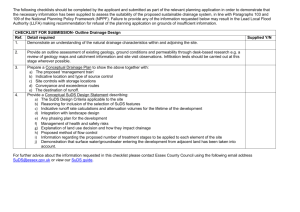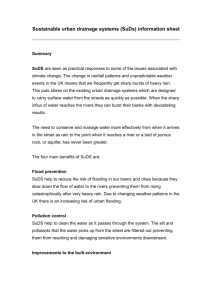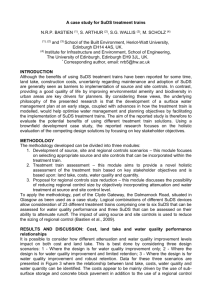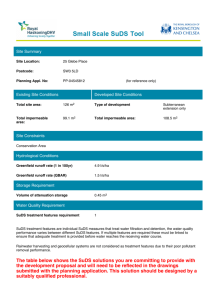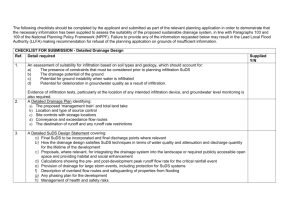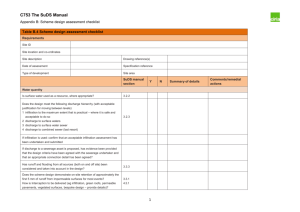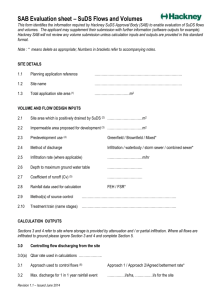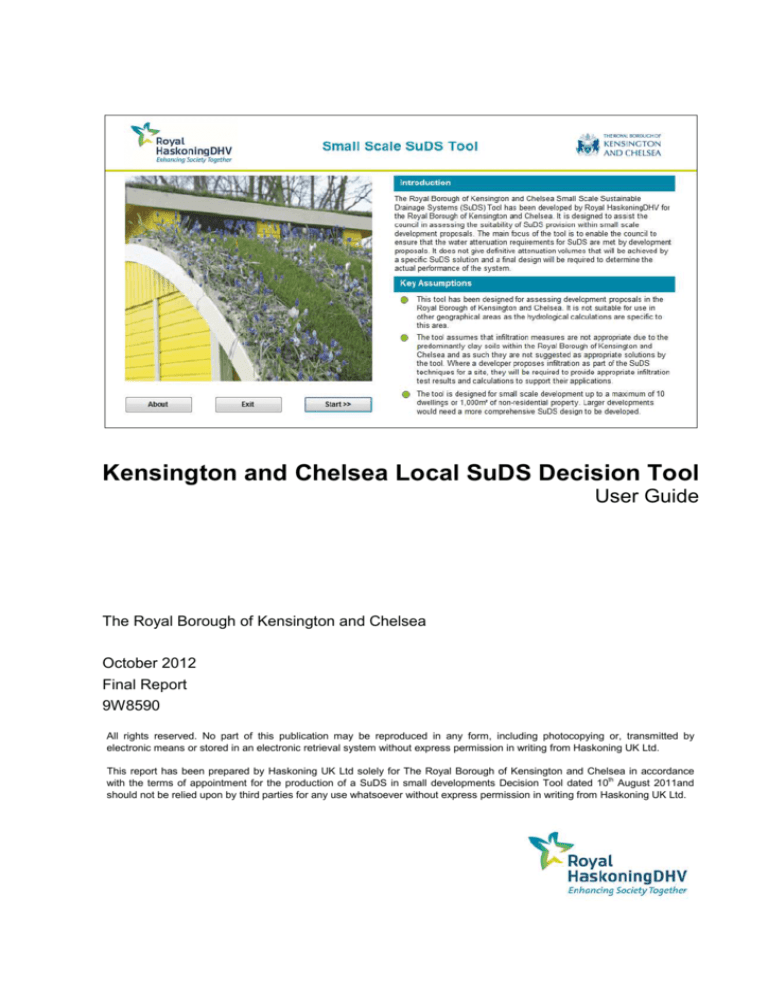
Kensington and Chelsea Local SuDS Decision Tool
User Guide
The Royal Borough of Kensington and Chelsea
October 2012
Final Report
9W8590
All rights reserved. No part of this publication may be reproduced in any form, including photocopying or, transmitted by
electronic means or stored in an electronic retrieval system without express permission in writing from Haskoning UK Ltd.
This report has been prepared by Haskoning UK Ltd solely for The Royal Borough of Kensington and Chelsea in accordance
with the terms of appointment for the production of a SuDS in small developments Decision Tool dated 10th August 2011and
should not be relied upon by third parties for any use whatsoever without express permission in writing from Haskoning UK Ltd.
HASKONING UK LTD.
WATER
Burns House
Harlands Road
Haywards Heath, West Sussex RH16 1PG
United Kingdom
+44 1444 458551
01444 440665
info@haywards-heath.royalhaskoning.com
www.royalhaskoning.com
Document title
Kensington and Chelsea Local SuDS
Decision Tool
User Guide
Document short title
Status
Date
Project name
Project number
Client
SuDS Decision Tool – User Guide
Final Report
October 2012
SuDS in Small Developments Decision Tool
9W8590
The Royal Borough of Kensington and
Chelsea
Reference
9W8590/R120914/303313/Hayw
Drafted by
Richard Stevens
Checked by
Date/initials check
Approved by
Date/initials approval
Folahan Ogunyoye / Helena Wicks
14/09/12
HW
Folahan Ogunyoye
14/09/12
FO
A company of Royal Haskoning
Telephone
Fax
E-mail
Internet
CONTENTS
Page
1
INTRODUCTION
1
2
COPYRIGHTS AND DISCLAIMERS
2
3
DATA INPUT
3.1
3.2
3.3
3.4
3
3
3
4
6
Existing Site Conditions
Developed Site Conditions
Site Constraints
Example Completed Data Input Form
4
APPROPRIATE SUDS AND VOLUME REQUIREMENTS
4.1
Indicative Attenuation Storage Volumes
4.2
SuDS Guidance
7
7
8
5
REPORTING
9
6
EXITING THE DATABASE
9
APPENDIX A – EXAMPLE REPORT
10
SuDS Decision Tool – User Guide
Final Report
9W8590/R120914/303313/Hayw
-iii-
October 2012
9W8590/R120914/303313/Hayw
October 2012
SuDS Decision Tool – User Guide
-iv-
Final Report
1
INTRODUCTION
This document gives a brief overview of how to use the Royal Borough of Kensington
and Chelsea (RBKC) Small Scale SuDS Decision Tool. The tool is a Microsoft Access
database. To open the tool double click on Small Scale SuDS Tool.mdb. The tool is
designed such that for each individual development application a new database is used
from a master copy. Once the master copy has been opened the database should be
saved with a new file name that includes the unique planning application reference
number.
This is the front screen and from here you can access the data input sheet of the tool. It
sets out the background and key assumptions to the tool that any new user should read
and understand before starting to use the tool.
The about button gives the user information about the origins of the tool and its legal
status as shown below:
SuDS Decision Tool – User Guide
Final Report
9W8590/R120914/303313/Hayw
-1-
October 2012
To start using the tool the user needs to click on the start button to access the data input
page.
2
COPYRIGHTS AND DISCLAIMERS
Any use or re-use of the tool is subject to the restrictions set out in the About
information box. Any external modifications carried out to the tool cannot be verified in
terms of the outputs derived as a result of these amendments.
The tool provides a summary of the SuDS solutions that the user is committing to
provide with the development proposal and will need to be reflected in the drawings
submitted with the planning application. This should be designed by a suitably qualified
professional.
The use of the tool and submission of the output report is deemed to be a declaration of
honesty that the tool has been used in the manner it was intended without external
amendment or modification.
9W8590/R120914/303313/Hayw
October 2012
SuDS Decision Tool – User Guide
-2-
Final Report
3
DATA INPUT
The data input page allows the user to input the required information about the
development proposal. The data input page is shown below:
Site location, postcode and planning application reference are entered in the appropriate
boxes to enable easy identification of the development proposal.
3.1
Existing Site Conditions
The existing site conditions of the total site area and existing impermeable area on the
site are entered into the appropriate boxes to allow the tool to calculate the hydrological
conditions and requirements.
An ‘i’ box is included beside the Impermeable area of existing site to provide further
guidance. These are used throughout the tool for this purpose and can be accessed by
clicking on the ‘i’ symbol.
3.2
Developed Site Conditions
The developed site conditions required by the tool are the type of new development
being considered and the impermeable area of the site which will result from this
development. A list of possible new development types can be entered from the drop-
SuDS Decision Tool – User Guide
Final Report
9W8590/R120914/303313/Hayw
-3-
October 2012
down list supplied. Development types not on this list have not been considered by the
tool. An ‘i’ box is included beside to provide further guidance.
The area of impermeable ground surface after development is required to calculate the
hyrdological requirements for the SuDS solution. An ‘i’ box is included beside to provide
further guidance.
The type of surfaces present in the new development affect the number of water quality
treatment stages required by the SuDS solution. This is based on the guidance provided
by the SuDS Manual (CIRIA 2007). The type of surface present in the development can
be selected from the drop down box as shown below. An ‘i’ box is included beside to
provide further guidance.
3.3
Site Constraints
There are site specific constraints within RBKC that may affect the use of certain types
of SuDS. If one of the appropriate constraints applies to the development proposal in
question then the corresponding tick box should be selected.
The majority of the borough is designated a conservation area for heritage reasons and
there are numerous listed properties. To assist the user in deciding whether the property
is within a conservation area a map is included within the tool that can be opened when
the View Map button is clicked. Once opened the map can be enlarged by clicking on
the appropriate location as shown below.
9W8590/R120914/303313/Hayw
October 2012
SuDS Decision Tool – User Guide
-4-
Final Report
If a property is listed or the development is located within a conservation area this may
impact upon the types of SuDS features than can be applied. Green roofs in particular
may be an issue if they alter the apperance of the area or the property being developed.
RBKC should be consulted to determine the restrictions that would apply.
SuDS Decision Tool – User Guide
Final Report
9W8590/R120914/303313/Hayw
-5-
October 2012
3.4
Example Completed Data Input Form
Below is an example of a completed data input form for a theoretical development.
9W8590/R120914/303313/Hayw
October 2012
SuDS Decision Tool – User Guide
-6-
Final Report
4
APPROPRIATE SUDS AND VOLUME REQUIREMENTS
Clicking on the next button from the data input form will take the user to the second form
of the tool which provides an indicative appraisal of the applicable SuDS features which
could supply the necessary attenuation storage. This can be compared with the required
attenuation storage calculated by the tool which is displayed in the box at the bottom of
the form. The appropriate SuDS features are dependent upon the type of development
and are listed with the ranking appropriate to RBKC. In addition the number of treatment
features required to achieve the water quality requirements is also indicated. An
example is shown below:
4.1
Indicative Attenuation Storage Volumes
For some of the SuDS features suggested the user can input a size and the tool will give
a range of attenuation storage volumes that could be achieved. These volumes are
indicative and would change depending upon site specific considerations and
constraints that may affect the SuDS features. The size is inputted either in terms of the
surface area covered by the SuDS feature (e.g. permeable pavements, ponds and
basins), length (e.g. swales) or number of properties (e.g. rainwater harvesting). The
total range of attenuation storage that may be achieved by the combination of SuDS
selected is given in the box below the individual SuDS types. The colour of the box will
change depending upon whether enough storage has been provided or not. If there is
too little it will remain red, if the volume required sits between the upper and lower
estimate of the volume potentially provided it will be amber and green amount required
is lower than the lower end of the range that potentially is being provided.
SuDS Decision Tool – User Guide
Final Report
9W8590/R120914/303313/Hayw
-7-
October 2012
An example of a completed form is shown below:
4.2
SuDS Guidance
Additional guidance on the different types of SuDS features is also available by clicking
the guidance button. This displays a new window which informs the user what the
feature is, basic best practice guidance on their design and directs the user to sources
of further information that should be consulted to undertake detailed designs. The
guidance box for green roofs is shown below as an example:
9W8590/R120914/303313/Hayw
October 2012
SuDS Decision Tool – User Guide
-8-
Final Report
5
REPORTING
Once the data input and attenuation storage volume forms have been completed the
user can produce a report outlining the results of the tool. By clicking the Preview Report
button at the bottom of the form the user will see the message below to ensure they are
happy with the outputs before moving onto the final report.
The report gives all the relevant information supplied by the user, indicative sizes of
appropriate SuDS, the hydrological conditions and attenuation requirements, water
quality requirements and relevant guidance for all the SuDS features that could be used.
An example report for a theoretical development is shown in Appendix A.
To save the report electronically it can be printed to a .pdf document or, alternatively, a
hard copy of the report may be printed.
6
EXITING THE DATABASE
To exit the database the user can click on the exit button on any of the forms.
SuDS Decision Tool – User Guide
Final Report
9W8590/R120914/303313/Hayw
-9-
October 2012
Appendix A – Example Report
A company of Royal Haskoning
SuDS Decision Tool – User Guide
Final Report
9W8590/R120914/303313/Hayw
-11-
October 2012
Small Scale SuDS Tool
Site Summary
Site Location
15 Hollywood Road, Royal Borough of Kensington and Chelsea, London
Postcode
SW10 9HT
Planning Appl. No.
App001
(for reference only)
Existing Site Conditions
Total area of site
Developed Site Conditions
100
m²
Type of development
60
m²
Total impermeable area 80
Total impermeable area
Extension
m²
Site Constraints
Conservation Area
Hydrological Conditions
Greenfield runoff rate (1 in 100yr)
4.9
l/s/ha
Greenfield runoff rate (QBAR)
1.5
l/s/ha
Storage Requirement
1.00
Volume of attenuation storage
m³
Water Quality Requirement
SuDS treatment features required
1
SuDS treatment features are individual SuDS measures that treat water filtration and detention, the water quality
performance varies between different SuDS features. If multiple features are required these must be linked to ensure that
adequate treatment is provided before water reaches the receiving water course.
Rainwater harvesting and geocellular systems are not considered as treatment features due to their poor pollutant removal
performance.
The table below shows the SuDS solutions you are committing to provide with the
development proposal and will need to be reflected in the drawings submitted with the
planning application. This solution should be designed by a suitably qualified
professional.
Appropriate SuDS Solutions
Rank
Proposed Size of
SuDS Options
1
Green Roofs
May be inappropriate due to
conservation area/listed building.
25 m²
1
Brown Roofs
May be inappropriate due to
conservation area/listed building.
m²
1
Rainwater Harvesting
3
Geocellular Systems
1 properties
m²
Potential Volume of
Attenuation
0.63
to
2.88
to
2.00
to
to
m³
m³
2.00
m³
m³
Small Scale SuDS Tool
Proposed indicative volume of attenuation storage
2.63
to
4.88 m³
Yes
SuDS treatment features are individual SuDS measures that treat water filtration and detention, the water quality varies
between different SuDS features. If multiple features are required these must be linked to ensure that adequate treatment is
provided before water reaches the receiving water course.
Guidance
Green Roofs
Green roofs comprise systems that cover the roof of a building with a vegetation cover
over a drainage layer. They intercept and store rainwater attenuating flows and
improving water quality.
The water storage capacity is highly dependent upon site-specific considerations,
however the main factors are vegetation cover, and the size of the drainage layer that
the building can support. The range of indicative storage volumes suggested is based
upon the impact of different types of vegetation cover in a typical situation. If the roof
has the capacity to accept higher than normal loading its storage capacity could
increase.
Further information can be found in the SuDS Manual (CIRIA 2007) and the
Environment Agency’s Green Roof Toolkit. Detailed guidance on the design of green
roofs for run-off attenuation has been developed in Germany by Forchungsgellschaft
Landschaftsentwicklung und Landschaftsbau.
http://www.ciria.com/
http://www.environment-agency.gov.uk/
http://www.fll.de/
RBKC accepts no responsibility for data held on other websites, the location of which
may be changed by the third party without notice.
Brown Roofs
Brown roofs comprise systems that cover the roof of a building with vegetation cover
over a drainage layer. They intercept and store rainwater attenuating flows and
improving water quality.
Brown roofs are similar to green roofs, sharing many of the same benefits and
construction methods. However the focus is to deliver biodiversity benefits in terms of
variety of species and habitat provision.
The water storage capacity is highly dependent upon site-specific considerations,
however the main factors are vegetation cover, and the size of the drainage layer that
the building can support. The range of indicative storage volumes suggested is based
upon the impact of different types of vegetation cover in a typical situation. If the roof
has the capacity to accept higher than normal loading its storage capacity could
increase.
Further information can be found in the SuDS Manual (CIRIA 2007), the Environment
Agency’s Green Roof Toolkit and at BrownRoofs.co.uk. Detailed guidance on the
design of green roofs for run-off attenuation has been developed in Germany by
Forchungsgellschaft Landschaftsentwicklung und Landschaftsbau.
Http://www.ciria.com/
http://www.environment-agency.gov.uk/
http://www.fll.de/
http://www.brownroofs.co.uk/
RBKC accepts no responsibility for data held on other websites, the location of which
may be changed by the third party without notice.
Small Scale SuDS Tool
Rainwater Harvesting
Rainwater harvesting involves storing rainwater that falls onto roof surfaces for use by
the property owner. This can vary between relatively small water butts and more
complex systems incorporating underground storage tanks. Water butts are not
generally designed to provide storage of rainwater in extreme events and therefore
cannot be included as part of the storage assessment for a site. This is the case
because if they are already full they will not provide storage in any given rainfall event.
Rainwater harvesting systems are generally larger and offer greater potential for
management of storm water in addition to providing water for reuse within properties.
The amount of storage that can be provided for dealing with storm water is dependent
upon the system installed, however the SuDS Manual suggests that for a standard
house the typical storm water component is 2m³ (CIRIA, 2007).
http://www.ciria.com/
http://www.environment-agency.gov.uk/
RBKC accepts no responsibility for data held on other websites, the location of which
may be changed by the third party without notice.
Geocellular Systems
Geocellular systems are typically modular plastic systems with high void ratios that can
be used to create below ground storage structures. They provide significant storage
volumes and flow attenuation, however do not provide any of the other benefits of
SuDS such as treatment, ecology or amenity.
The SuDS Manual (CIRIA, 2007) states that geocellular systems should be designed in
accordance with Sewers for Adoption 6th Edition (WRc, 2006). The typical void ratio for
tanked systems is 0.9; therefore the storage capacity can be taken as 90% of the
volume of the storage layer. The typical depths of storage tanks vary between 0.2m
and 0.5m depending upon the product used.
The range of indicative storage volumes suggested is based upon the range of
systems avalable on the market. The amount of storage may be increased if products
allow multiple layers to be used and there are no other site-specific constraints.
http://www.ciria.com/
http://www.environment-agency.gov.uk/
RBKC accepts no responsibility for data held on other websites, the location of which
may be changed by the third party without notice.

